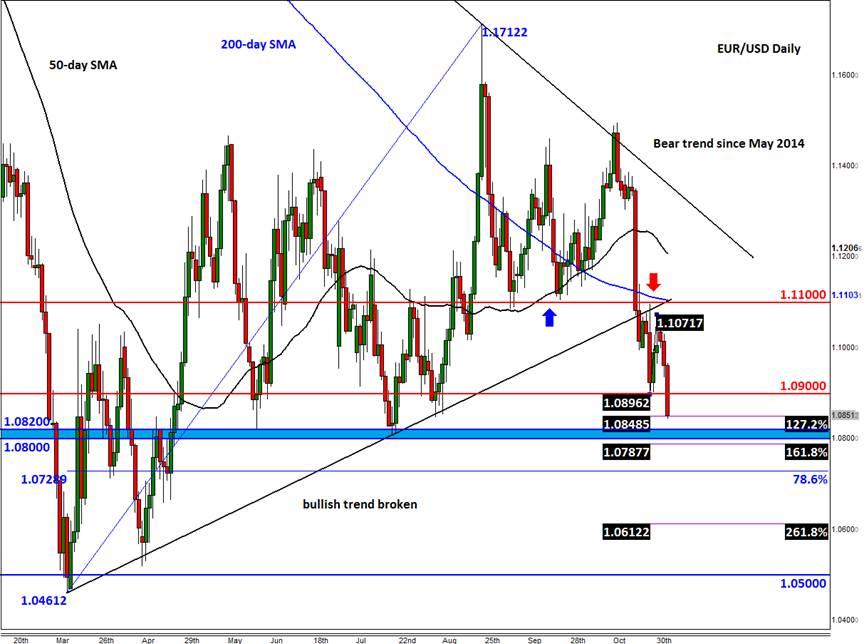![]()
The EUR/USD has fallen to its lowest level since July. Evidently, investors are continuing to favour the higher-yielding dollar over the euro amid the growing disparity between the European Central Bank and Federal Reserve’s monetary policies. Whereas the ECB is contemplating on increasing its monetary stimuli in December, the Fed is seriously considering a first rate increase in more than a decade in the same month. Today saw the dollar take another lurch higher, finding support from stronger-than-expected US economic data and hawkish comments from Janet Yellen that the downside risks to the US economy are diminishing and that a December rate increase remains a "live possibility." A live possibility it may well be if last month’s employment report, due on Friday, shows solid gains in non-farm payrolls and wages. And judging by the latest jobs market data and the corresponding reaction of the financial markets, traders are certainly starting to price in this possibility.
Indeed, the closely-watched employment component of the US ISM Non-Manufacturing PMI for October rose nearly a whole point to 59.2, while the ADP private sector jobs reports showed a solid 182 thousand job gains in October. Today’s other US macro numbers were likewise better than had been anticipated with the ISM non-manufacturing PMI unexpectedly climbing 2.2 points to 59.1 from 56.9 and the US trade deficit narrowing sharply in September to $40.8 billion from $48.0 billion the month before. Earlier today, the latest services PMI data out of the Eurozone were mixed with downward revision in Germany offsetting gains in countries like Spain. As a result, the final Eurozone services PMI was revised a touch lower to 54.1 from 54.2 previously.
Following the release of stronger US data today, the yield on the US two-year Treasury note rose to its highest level since April 2011, while the fed funds futures implied a probability of 58% that the lift off will occur in December – an increase of 4 percentage points from the day before. Consequently, the EUR/USD has dropped to a low so far of 1.0845, its lowest level since July 21. The next key support for the world’s most heavily-traded FX pair comes in around 1.0800/20, which corresponds with the low hit in July. Below this level, there’s little further support seen until the 78.6% Fibonacci retracement at 1.0725/30, followed by the March low at 1.0460. For the euro to breach the March low and head towards parity, we will need to see continued hawkish talk from Fed and a significant improvement in US data, starting with the jobs report on Friday. Meanwhile some short-term resistance levels to watch include 1.0900, the previous support, followed by 1.1000 and then 1.1100. The bulls would do very well to push rates back towards 1.1100, let alone break above it. But they may get a helping hand from a disappointing US jobs report on Friday. But for now at least, the path of least resistance is clearly to the downside.
Figure 1:
Trading leveraged products such as FX, CFDs and Spread Bets carry a high level of risk which means you could lose your capital and is therefore not suitable for all investors. All of this website’s contents and information provided by Fawad Razaqzada elsewhere, such as on telegram and other social channels, including news, opinions, market analyses, trade ideas, trade signals or other information are solely provided as general market commentary and do not constitute a recommendation or investment advice. Please ensure you fully understand the risks involved by reading our disclaimer, terms and policies.
Recommended Content
Editors’ Picks
EUR/USD extends gains above 1.0700, focus on key US data

EUR/USD meets fresh demand and rises toward 1.0750 in the European session on Thursday. Renewed US Dollar weakness offsets the risk-off market environment, supporting the pair ahead of the key US GDP and PCE inflation data.
USD/JPY keeps pushing higher, eyes 156.00 ahead of US GDP data

USD/JPY keeps breaking into its highest chart territory since June of 1990 early Thursday, recapturing 155.50 for the first time in 34 years as the Japanese Yen remains vulnerable, despite looming intervention risks. The focus shifts to Thursday's US GDP report and the BoJ decision on Friday.
Gold closes below key $2,318 support, US GDP holds the key

Gold price is breathing a sigh of relief early Thursday after testing offers near $2,315 once again. Broad risk-aversion seems to be helping Gold find a floor, as traders refrain from placing any fresh directional bets on the bright metal ahead of the preliminary reading of the US first-quarter GDP due later on Thursday.
Injective price weakness persists despite over 5.9 million INJ tokens burned

Injective price is trading with a bearish bias, stuck in the lower section of the market range. The bearish outlook abounds despite the network's deflationary efforts to pump the price.
US Q1 GDP Preview: Economic growth set to remain firm in, albeit easing from Q4

The United States Gross Domestic Product (GDP) is seen expanding at an annualized rate of 2.5% in Q1. The current resilience of the US economy bolsters the case for a soft landing.
